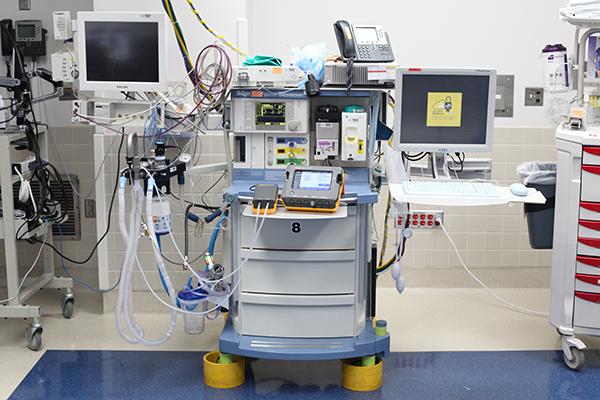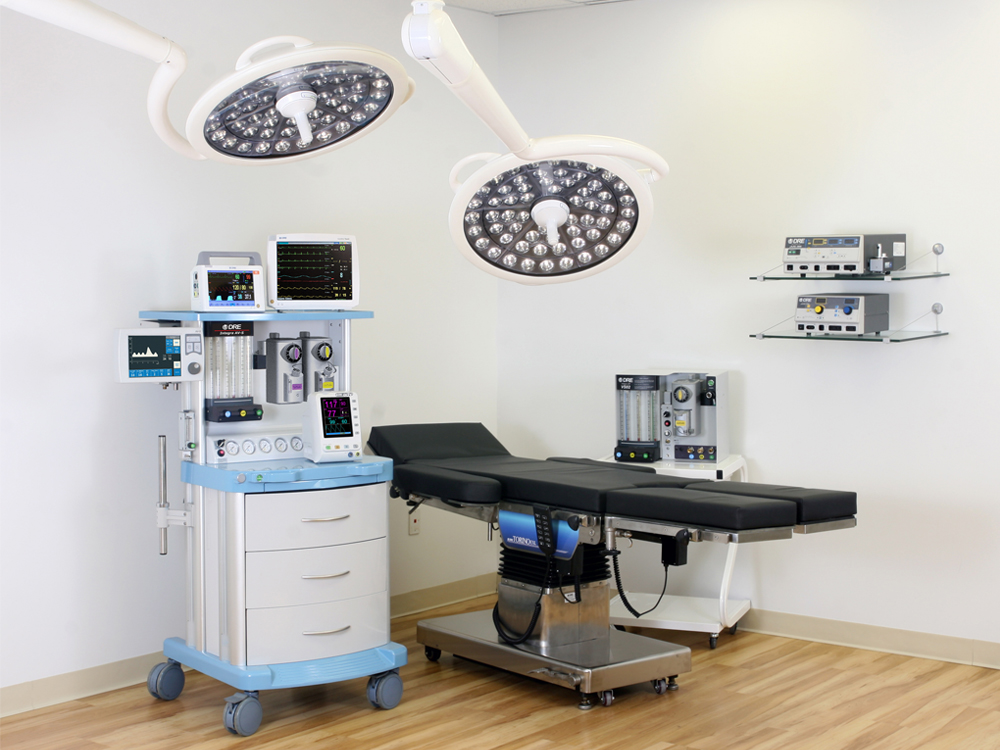In healthcare institutions, anesthesia machines are essential equipment for the protection of patients during operations and other medical procedures. Choosing the best anesthesia machine might be challenging because of the many options available. This blog gives you a thorough overview of the factors to take into account when purchasing an anesthesia machine.
What is an Anesthesia Machine?
An anesthetic machine is a tool used to provide patients with general anesthesia while they undergo medical treatment. This machine is used by anesthesia assistants under the direct supervision of anesthetic specialists during general anesthesia. The machine provides an accurate and continuous supply of medical gases (such as oxygen and nitrogen oxide) and anesthetic vapors (such as isoflurane) under safe flow and pressure. A ventilator, a suction unit, and patient monitoring equipment are also included in modern anesthesia machines.
How does an Anesthesia Machine work?

Anesthesia drugs are of two types. One of them knocks out the entire body (general anesthesia) and the other one just numbs the specific body part (local anesthesia).
To prevent the transmission of pain signals to the brain, local anesthetics block the nerves that connect a specific body part or region to the brain. Examples are the injection of novocaine, which dentists use to numb the nerves in the mouth during a root canal, and epidurals, which enable a (relatively) pain-free childbirth by blocking the nerves that form at the spinal cord’s base and serve the pelvic region.
On the other hand, general anesthesia is used in complex surgical procedures where the patient needs to be entirely unconscious. As a result, patients are rendered unconscious and have no impression of or memory of the procedure (although the pain from the surgery is evident upon awakening). Additionally, it controls the physiological reaction to surgical incisions, keeps blood pressure stable, and reduces the release of stress hormones while increasing heart rate.
How to Buy Anesthesia Machines – A Step-by-Step Guide
Making an informed decision that prioritizes patient safety, functionality, reliability, and cost-effectiveness is crucial when purchasing anesthesia machines.
Analyze Your Requirements
It’s important to evaluate your demands and requirements before starting your search for anesthesia equipment. The number of procedures carried out, the complexity of surgeries, the available budget, and the types of patients you serve are all things to take into account. The evaluation will assist in choosing the best anesthesia equipment type for your facility.
Types of Anesthesia Machines
There are numerous varieties of anesthesia machines, each with particular characteristics and powers. But there are two main categories:
Continuous Flow Anesthesia Machines: These devices continuously dispense gas to the patient while manually or automatically adjusting the gas mixes. They are appropriate for facilities with moderate patient loads and are frequently utilized in regular surgical procedures.
Controlled Anesthesia Machines: Advanced ventilation settings, integrated monitors, and electronic record-keeping capabilities are just a few of the advanced features offered by these devices. They are perfect for intricate operations and intensive care units where sophisticated monitoring and management are needed.
Analyze Safety Features
You need to put patient safety first when making an anesthesia machine purchase. Look for equipment that includes key safety measures, such as:
Oxygen Failure Protection
Even in the unlikely case of a malfunction, these devices guarantee a constant flow of oxygen.
Pressure Relief Valves
These valves stop the breathing circuit from building up too much pressure.
Gas monitoring capabilities
The concentration of gases exhaled and inhaled is monitored with gas monitoring systems.
Alarm Systems
In the event of critical changes in pressure, oxygen levels, or other factors, audible and visible alerts notify medical staff.
Analyze Functionalities and Features
Consider the functionality and features you need in an anesthesia machine depending on the operations carried out in your facility. Important aspects to take into account include:
Modes of ventilation
Controlled ventilation, pressure support, and spontaneous breathing are all possible with various ventilation modes.
Built-in monitors
The procedure of monitoring vital signs, gas concentrations, and other pertinent information is made simpler by devices like built-in monitors.
Vaporizer compatibility
To deliver volatile anesthetics in your facility, make sure the machine is compatible with the specific vaporizers used there.
User interface and ergonomics:
Look for devices with user interfaces that are simple to understand and with ergonomic designs that reduce user error.
Reliability and quality
To maintain its long-term performance and reduce downtime, it is essential to invest in a reliable and durable anesthesia machine. Take into account elements including the manufacturer’s reputation, warranty coverage, the accessibility of replacement parts, and post-purchase assistance. Reading reviews and getting referrals from reliable sources can give you important knowledge about the caliber and dependability of various brands and models.
Additional Factors to Consider
Size
Anesthesia machines exist in a variety of shapes and sizes, from small, portable devices to bigger, more feature-rich ones. The amount of gas and vaporizer positions, breathing systems, auxiliary gas outputs, and other monitoring and support features are some examples of elements that affect machine size.
Portability
A portable anesthesia machine can be the best option if your hospital routinely performs treatments in different locations or lacks dedicated space. Portable units are small, light, and simple to move. They often have a simple layout, fewer gas and vaporizer stations, and less complicated monitoring options.
Budget
It’s crucial to prioritize patient safety and functionality while also taking your budget into account. Consider the long-term value and maintenance costs when comparing prices from various vendors and manufacturers. Keep in mind that if a product sacrifices quality or is missing necessary features, it might not always be the most economical option in the long term.
Future Needs
Last but not least, while purchasing an anesthesia machine, future needs must be taken into account. Analyze your facility’s capacity for expansion and the likelihood that surgical techniques or patient numbers will alter. Long-term expenditures can be reduced and premature replacements can be avoided by investing in a scalable anesthesia machine that can adapt to changing demand.
Mistakes to Avoid When Purchasing Anesthesia Machines
When purchasing an anesthesia machine, avoid these typical mistakes:
- Selecting a device primarily based on cost.
- Neglecting to take regulatory compliance and safety features into account.
- Ignoring the necessity of routine upkeep and repair.
- Not taking into account the machine’s compatibility with other medical equipment.
Conclusion
The safety and well-being of patients during medical procedures and surgeries depend on selecting the right anesthesia machine. Consider safety features, ventilation modes, monitoring capabilities, anesthesia agent vaporizers, and compatibility with other medical equipment when choosing an anesthesia machine. Also take into account extra qualities like size, portability, maintenance needs, and cost. You can choose an anesthesia machine that satisfies the needs and specifications of your facility by following the suggestions in this article and avoiding typical mistakes.
FAQs
What are Anesthesia Machines?
Anesthesia machine provides anesthetic gases and drugs to a patient during a procedure or operation.
Why is it Important to Choose the Right Anesthesia Machine?
For the patient’s safety and comfort, selecting the right anesthesia machine is essential. Complications include respiratory failure, hypoxia, and even death can result from an anesthesia machine that isn’t properly maintained or isn’t working at all.
What Are Anesthesia Machines Used for?
The anesthesia machines are used for:
- Providing Co2
- Providing EKG
- Blood Pressure Monitoring
- Pulse & Temperature monitoring
- Mixing anesthetic gases and vapors
- Enabling patient ventilation
- Minimizing anesthesia-related risks
What are the types of Anesthesia Machines?
There are two types of Anesthesia Machines available:
- Portable Anesthesia Devices: The purpose of portable anesthesia equipment is to be used in remote or temporary medical facilities. They are perfect for medical missions, disaster relief initiatives, and outdoor events because they are lightweight, small, and easy to carry.
- Standalone Anesthesia Machines: Hospitals, clinics, and other healthcare facilities frequently use standalone anesthesia machines. They offer a wider range of features and capabilities than portable anesthesia devices and are bigger and more complicated to operate.
Which Brand is Best for Anesthesia Machines?
The following is a list of top anesthesia machine brands:
- GE Datex
- PRO-NOX
- PENLON
- Accutron
- Ohmeda




